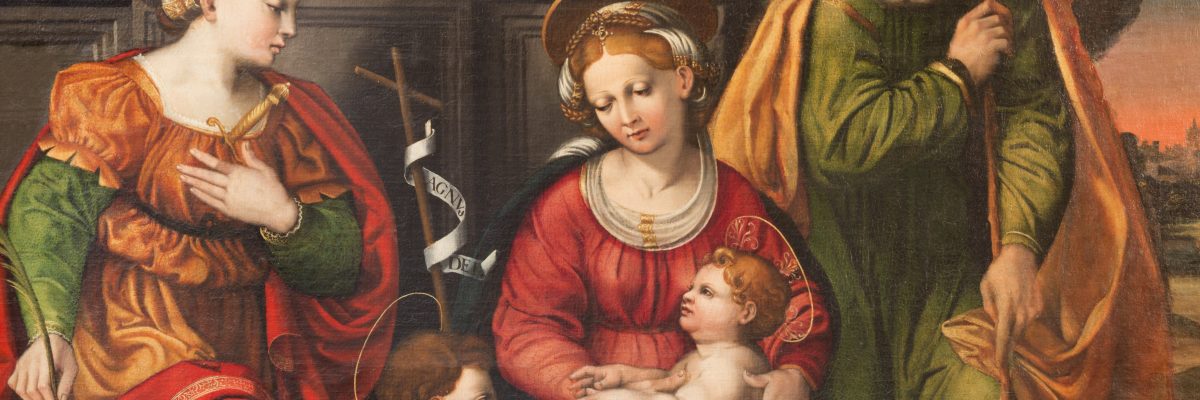
The child grew and became strong in spirit, and he was in the desert until the day of his manifestation to Israel (Luke 1:80).
Babies are often described as innocent, and to be sure they are, as far as actual sin goes, since they do not have the use of reason. But anyone who has ever cared for a baby (or has been on many transcontinental flights!) knows that a baby does not act so innocently. A baby has emotions that are definitely marked by our fallen nature and so is really and truly morally imperfect.
In fact, our care for an infant, after we have fed and bathed and clothed him, is to teach him little by little to express his desires and to react to others in a reasonable and not a passionate way. St. Augustine in his Confessions describes the envious competition of two babies being nursed at the same time and takes this as clear evidence of original sin. Cute little babies are hardly inclined to share when their desires are at stake, and so even if they are not sinners, they behave in many ways that would be if they were imputable.
This is why Holy Church does not celebrate the birthdays of her saints, but rather the days of their deaths—that is, their “heavenly birthdays.” Or, for a few, the day of another event that speaks of the life of grace, such as the day of their conversion or baptism or ordination, or of the translation of their relics from one city to another. This is of course because the liturgy of the Church celebrates supernatural life and the events that express its beginning and its full development, not just the fact of our natural life and existence.
So when the Church does celebrate the birth and infancy of one of her holy ones, it is a notable exception that implies something similarly exceptional about the one so celebrated. In fact, only Christ Jesus, his holy mother, and St. John the Baptist, whom we celebrated Saturday, are venerated in the sacred liturgy in their births and childhoods. This is a significant sign to us. It means that by the time they were born into the light, they were already saints.
In the case of Our Lord and Our Lady, they were utterly free from original sin, and so this is easy to see. But in the case of John the Baptist, the tradition of the Church holds that he was sanctified in the womb of St. Elizabeth. St. Luke’s Gospel describes him leaping in the womb upon hearing the greeting Our Lady returned to that of his mother. And the angel Gabriel himself tells his father, St. Zachary, that his son will be full of the Holy Spirit from his mother’s womb.
That John was sanctified in the womb of his mother is the practically unanimous teaching of the Fathers and Doctors of the Church. St. Augustine and St. Thomas clarified the sense of his liberation carefully. Such an exceptional grace is for an exceptional mission, and it implies complete freedom not only from deliberate sin, but from any disordered feelings that contradict reason and faith.
Thus it is that Holy Church practices a devotion to the holy infancy of Christ, and of Mary, and of John the Baptist. They were truly saints from their mothers’ wombs. They were as Christ was: “like us in all things but sin.” This is why there are so many images in Catholic art of the Child Jesus and John the Baptist, and also of Our Lady in her childhood. These three are the only saints to be venerated as children, with feast days of their childhood. (There are, of course, the Holy Innocents, but there the sanctification was by violent martyrdom—yet they too are venerated in their infancy.)
Modern Catholics, to some extent, sometimes lack a sense of the value of devotion to the holy childhoods of Jesus, Mary, and John. How often does one hear wry comments about the images of the Infant of Prague? And there is little sense that devotion to Our Lord’s infancy is a devotion for adults. Even so, the liturgy of the Church, which is our best teacher, has at least five feasts set in Our Lord’s infancy and childhood, and it has three for Our Lady, and two for John, one of which was this weekend’s solemnity.
How are we to understand John’s infancy as a source of grace and an object of veneration? Just consider that the life of grace is a real life passed on by concrete actions and events, just like our natural life. Have you ever considered that you pray the Hail Mary in a continuous chain that reaches back to the little newly sanctified John’s leaping in Elizabeth’s womb and inspiring her to exclaim, “Hail full of grace, the Lord is with thee”? So thank the baby John for the Hail Mary, or at least a part of it.
Consider as well that he was sanctified by the presence of Jesus, who gave him grace at the sound of Mary’s voice, and thank him that he is the first to show us how we go to Jesus through Mary. Consider that his freedom from the passions enabled him to go out into the desert from his youth and to live a contemplative life in preparation for his preaching, and thank him for his example of prayer and his continuous and powerful intercession for each one of us.
Of his prayer and contemplation of the mystery of the Word made flesh, St. John the Evangelist tells us in the prologue to his Gospel that all have believed through the testimony of John the Baptist. That means you and me. So thank him today, and ask him to obtain for you perseverance in the Faith.



